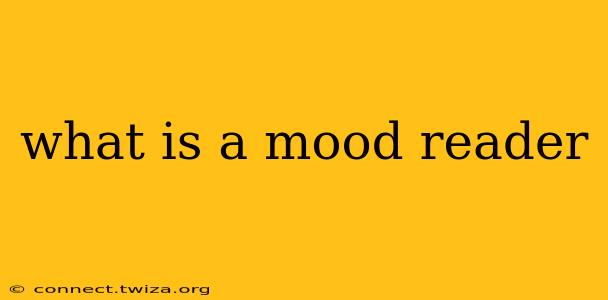Feeling overwhelmed by the sheer volume of books available? Wish you had a magical tool to instantly suggest the perfect read based on your current mood? That's where the concept of a "mood reader" comes in. It's not a physical device, but rather a system – be it an app, a website, or even a carefully curated personal method – designed to connect your emotional state with the ideal literary experience.
A mood reader, in its essence, is a personalized recommendation engine. It goes beyond simple genre classifications, delving deeper into the emotional landscape of books. Instead of simply suggesting "thrillers," it might suggest "thrillers that evoke a sense of suspenseful anticipation" or "thrillers that offer a satisfying sense of justice." The key is the nuanced understanding of emotional impact.
How Does a Mood Reader Work?
The mechanics of a mood reader can vary significantly depending on the platform or method used. Some common approaches include:
- User Input: Many digital mood readers start by asking you to describe your current mood – happy, sad, anxious, energized, etc. Some may even use more detailed questionnaires or mood trackers to refine their understanding of your emotional needs.
- Algorithmic Analysis: Sophisticated algorithms analyze vast databases of book descriptions, reviews, and reader feedback to identify patterns and connections between emotional states and literary elements. This allows for more accurate recommendations.
- Natural Language Processing (NLP): Advanced systems leverage NLP to understand the nuances of language within book descriptions and reviews, enabling a more precise matching of mood and content.
- Manual Curation: While less scalable, curated lists from book experts or passionate readers can provide insightful recommendations based on deep emotional understanding of individual books.
What are the Benefits of Using a Mood Reader?
- Discovery of Hidden Gems: Mood readers can help you uncover books you might never have found on your own, expanding your reading horizons beyond your typical choices.
- Improved Reading Experience: By aligning your reading material with your emotional state, you can enhance your enjoyment and engagement with the books you choose.
- Efficient Time Management: Instead of wasting time sifting through endless lists, a mood reader can quickly narrow down the options, saving you valuable time.
- Personalized Reading Journey: A mood reader allows you to tailor your reading experience to your individual needs and emotions, fostering a deeper connection with literature.
What are Some Examples of Mood Readers?
While a dedicated "mood reader" app may not yet exist in the mainstream, several services offer similar functionality. Goodreads, for example, allows you to rate books and specify your mood when reading them, though its recommendation engine isn't solely based on mood. Many book recommendation websites and apps also incorporate mood-related tags or filters. Ultimately, creating your own personalized mood reader system—with a thoughtfully curated spreadsheet or even a simple notebook—is a viable, and deeply personal, option.
What if I Don't Know My Mood?
Identifying your precise mood might seem challenging. However, consider taking a few moments to reflect on how you're feeling. Are you looking for a lighthearted escape? Do you need a thought-provoking read to stimulate your mind? Or perhaps you desire a comforting story to soothe your anxieties? Even a vague sense of your emotional state can guide a mood reader – or your own intuitive selection process.
Can a Mood Reader Replace Traditional Book Recommendations?
A mood reader should be seen as a complementary tool rather than a replacement for traditional recommendations. While mood is a powerful factor, genre, author preference, and literary style still play significant roles in choosing a book. Consider a mood reader as an extra layer of personalization to elevate your reading experience. The best approach often combines the insights of a mood reader with your existing preferences and knowledge.
